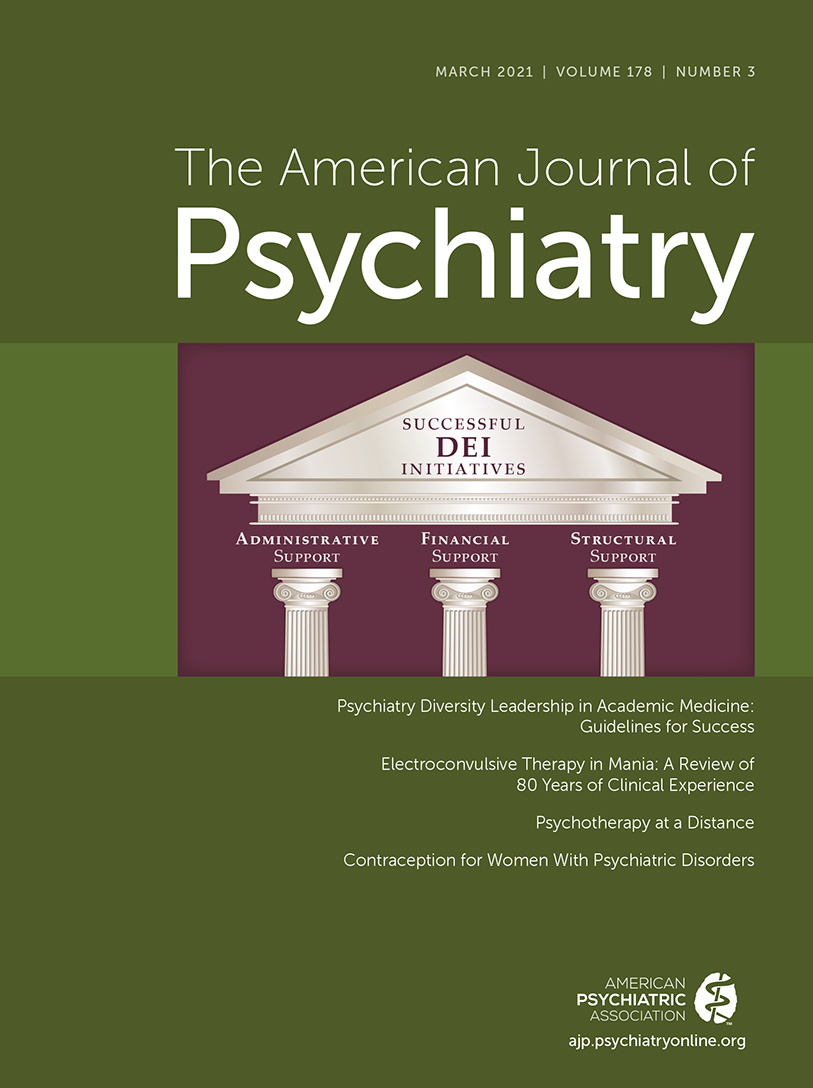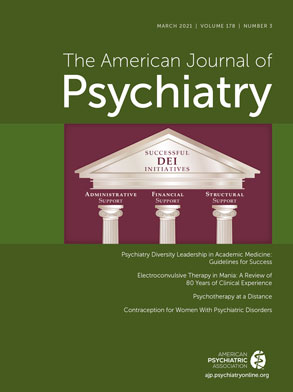The introduction of selective serotonin reuptake inhibitors (SSRIs) had a major impact on the treatment of depression, but there remain large numbers of patients whose symptoms are resistant to these and other agents. In recent years, drugs with alternative mechanisms of action have become the focus of efforts to develop novel treatments for patients with treatment-refractory depression. Some of these agents have mind-altering actions and/or abuse potential, but how best to focus attention on these risks has been a matter of some debate, and we have described a risk in minimizing the associated risks in adopting these newer agents into general use. Brexanolone is a member of a new class of antidepressants, the neurosteroid GABA
A receptor modulators, that has been approved for the treatment of postpartum depression. The rationale for this drug, in part, was that postpartum depression represents an acute deficiency in circulating levels of neurosteroids (
1). The drug is administered as an intravenous infusion over 60 hours on an inpatient basis. There are efforts under way to develop follow-on, orally administered compounds for postpartum depression or refractory depression. However, the rationale for using such compounds in refractory depression may have less to do with correcting a neurosteroid or allopregnanolone deficiency. The actual mechanism may have more to do with potential benzodiazepine-like effects through the GABA
A receptor. The implications of understanding mechanisms of action in developing psychotropic medications need to be brought into better focus for assessing both the benefits and the risks of their use.
Brexanolone and SAGE-217 (zuranolone) are neuroactive steroids and positive allosteric modulators of the GABA
A receptors, potentiating GABA-mediated currents (
2,
3). Brexanolone and SAGE-217 share several clinical effects with benzodiazepines that also act via GABA
A receptor activation. Both benzodiazepines and these neurosteroids are associated with similar effects, such as sedation, somnolence, and dizziness. In the 185 patients treated with brexanolone and SAGE-217 in the published phase 2 and 3 trials, 13.0% reported dizziness and 9.7% reported somnolence, compared with 6.0% and 4.0%, respectively, in placebo arms (
4–
6). The U.S. Food and Drug Administration required a risk evaluation and mitigation strategy (REMS) program for brexanolone after 4.3% of patients who received the medication developed a loss or an altered state of consciousness (
2). Similar symptoms can occur with benzodiazepine infusions and overdoses. Of interest, the efficacy of brexanolone and SAGE-217 has been or is being explored in refractory seizures, insomnia, and essential tremor, indications for which benzodiazepines are approved or are used off-label.
Although the rationale for using neurosteroids for postpartum depression is to correct a deficit in postparturition neurosteroid activity, the agents may behave more like a benzodiazepine than as a specific neuroendocrine replacement strategy. That mechanism of action may have some utility in depression, given that there is some literature showing that benzodiazepines can be used either as a monotherapy in some patients with depression or as an adjunct to classic antidepressant therapy (
7,
8). A benzodiazepine-like effect from neurosteroids needs to be evaluated in comparison with using more classic benzodiazepines as add-on treatments. Would it be better tolerated or more effective than adding alprazolam or clonazepam? Would it be safer than a benzodiazepine? If it were more effective and safer, that could be of benefit. If it is not particularly more effective or safer, there would be little potential benefit for the field.
A “human abuse potential” study suggests that brexanolone has misuse potential (
2). Using a crossover design, the study compared intravenous brexanolone at dosages of 90 μg/kg, 180 μg/kg, and 270 μg/kg (infused over 1 hour) with placebo and intravenous alprazolam at doses of 1.5 mg and 3 mg. Euphoria was reported in 3.1%, 9.4%, and 12.5% of patients receiving 90 μg/kg, 180 μg/kg, and 270 μg/kg of brexanolone, respectively (
9). When receiving alprazolam, 3% of patients reported euphoria at the 1.5-mg dose, and 19.4% reported euphoria at the 3-mg dose. In contrast to alprazolam, which had “good effects” scores peaking 2–4 hours after administration that remained elevated for 3–6 hours, “good effects” of brexanolone peaked 1–2 hours before “rapidly returning to placebo levels” (
2). To the best of our knowledge, abuse potential studies are not yet publicly available for SAGE-217.
Although access to brexanolone is restricted by the REMS program to a 60-hour inpatient infusion, the misuse potential of new GABAA receptor modulators increases if they are prescribed in the outpatient setting. SAGE-217 is a neurosteroid with oral bioavailability that is being tested in phase 3 clinical trials for postpartum depression and major depressive disorder. However, the published and registered phase 2 and phase 3 trials of brexanolone and SAGE-217 are limited for three reasons. First, ascertainment bias presents a challenge to the interpretation of randomized controlled trials evaluating the effects of the neurosteroid GABAA receptor modulators. The presence of “drug-liking” effects and discernible side effects reduces the effectiveness of blinding and increases the likelihood of placebo responses in the neurosteroid treatment groups.
Second, the clinical significance of short-term efficacy trials for long-term conditions is unclear. Primary endpoints were measured at 60 hours in the brexanolone phase 2 and 3 randomized controlled trials for postpartum depression and at 15 days in the completed SAGE-217 phase 2 and phase 3 randomized controlled trials for postpartum depression and major depressive disorder (
4–
6,
10,
11). After the MOUNTAIN study of SAGE-217 did not yield statistically significant results on the primary efficacy outcome, Sage Therapeutics paused a longer-term study of SAGE-217 and announced three new randomized controlled trials assessing 2-week courses of SAGE-217 (
10,
12). However, treatment for postpartum depression and major depressive episodes typically lasts months. Rapid onset of relief from depressive symptoms is important, but differences between the placebo and active groups dissipated in most published phase 2 and phase 3 trials after the conclusion of treatment. This is similar to some meta-analyses of benzodiazepines. A Cochrane review found transient treatment benefits from adding benzodiazepines to SSRIs over the initial 4 weeks, but these effects dissipated even with continued treatment (
8).
Third, published randomized controlled trials of brexanolone and SAGE-217 have not incorporated meaningful information to distinguish the reinforcing effects of a drug from its antidepressant effects. It is unclear whether the effects seen at 60 hours in the brexanolone studies and at 15 days in the SAGE-217 studies reflect “drug-liking” that short-term use of many controlled substances could produce. Such effects can similarly be challenging to distinguish in clinical practice. The published controlled trials need to provide important safety data pertinent to medications with reinforcing effects, such as whether tolerance develops with long-term use, whether withdrawal develops after discontinuation, and whether cravings or the urge to resume use develops after discontinuation.
Clinical trials assessing the new neurosteroids should be designed to provide information that is salient to clinicians and patients. First, trials should include placebo and benzodiazepine comparators; a benzodiazepine arm would reduce treatment ascertainment and partially control for reinforcing properties. A three-arm study design would also allow for an assessment of whether the rapid-acting benefits of the neurosteroids can be obtained with benzodiazepines. As noted above, benzodiazepines have been reported to have short-term antidepressant effects (
8), and they would be a great deal less expensive than neurosteroids. Precedence exists for including benzodiazepine comparators; studies of intravenous ketamine for treatment-refractory major depressive disorder used intravenous midazolam as a comparator. Second, comprehensive measures of tolerance, euphoria, dependence, craving, disinhibition, and rapid anxiolysis should be included not only in “abuse potential studies” but throughout phase 2 and phase 3 testing. Third, if indications are being sought for short-term treatment with GABA
A positive allosteric modulators, withdrawal and discontinuation symptoms—which may not be directly captured on depression rating scales—should be explicitly measured and reported when treatment is discontinued, even in shorter-term trials where they may be less problematic. An approved short-term treatment that is challenging for patients to discontinue can become a long-term treatment in clinical practice. After discontinuation, trial participants should undergo long-term monitoring for cravings, desire to resume use, and recall of “drug-liking” experiences. Fourth, minimum effect sizes and durations of effect necessary for drug approval should be increased when drugs have misuse potential.
There are important roles for benzodiazepines and other GABA
A receptor allosteric modulators in the treatment of psychiatric and neurologic conditions. Benzodiazepines are used in the treatment of seizures and alcohol withdrawal syndrome and in the short-term treatment of severe anxiety disorders (
13). Providing rapid relief from depressive symptoms is a major gap in the pharmacologic treatments of depression, with conventional antidepressants often taking 6–12 weeks to achieve maximal effects. If effective and safe, neurosteroids could help reduce suffering and distress for patients with depressive disorders and be preferable to benzodiazepines. Hopefully, neurosteroids will have low misuse and dependence formation and high long-term safety. Trials should not leave us guessing.

